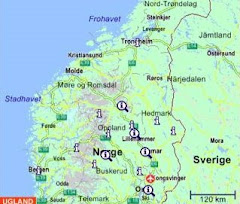 We spent nearly three hours at Stiklestad and took in only a fraction of its attractions. (Note the pink arrows on the Stiklestad Map.) After visiting the church and cemetery,
We spent nearly three hours at Stiklestad and took in only a fraction of its attractions. (Note the pink arrows on the Stiklestad Map.) After visiting the church and cemetery,
we
walked
down
the
street
to
the
culture
center.
(on the right)
There we walked through an exhibition portraying the time before and after the Battle of Stiklestad. The "walking drama" – called "The Changing Face of Faith" – represented Norway's transition from paganism to Christianity and recognized the Battle of 1030 as the turning point.
 Later we toured
Later we touredthe center's
upper level with
historical displays
and explanations,
including life-sized
mannequins and a
mini-replica of the
Nidaros Cathedral.

The
vibrant
floral
display
at the
foot of
Saint
Olav's
Monument
drew us
up the hill

to the place where Olav's body was kept the night after the Battle of Stiklestad
Alongside of the church (in the background), this hilltop is a most symbolic site. The first known monument here was a wooden cross with an iron cross on top. Later, the wooden cross was replaced with a brick monument and the original iron cross on top. This current monument is the oldest known public monument in Norway. Erected in 1807, it is the only one that pre-dates the adoption of the nation's constitution in 1814.
(Fun facts from the center's brochure)
All the historical impressions and physical climbing tired out many in our group. As a graduate of Scandinavian Studies, I felt compelled to take in ONE more climb before giving into rest.
 Kjell accompanied me to
Kjell accompanied me to "The Mounted King" statue
which stands above the open air theater – the place where thousands gather annually for "Saint Olav Drama."
The re-enactment – of the religious and cultural conflict between Olav Haraldsson's supporters and their opposition – is the highlight of the 10-day Saint Olav Festival,
which includes concerts, presentations, a medieval market and other activities for "kids of all ages."
"Some day..." I mused – as an ongoing student of Scandinavian Studies – "I too will partake!"

With
that,
we loaded
into the van
to drive onward...

...taking note of the adjacent site where archaeological excavation will soon begin.
Our guide
had noted that
this site,
once planned as a future parking lot, showed signs of being a viking burial ground. What then? Time will tell as workers continue to expand and draw in tourists to Stiklestad National Culture Center.

Meanwhile,
we watched
the wheat fields
go by in
Trøndelag –
Norway's
bread
basket.




No comments:
Post a Comment